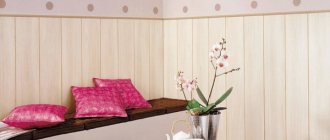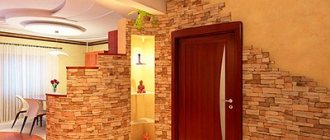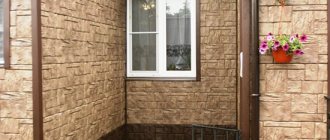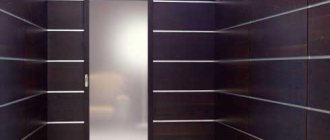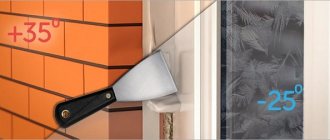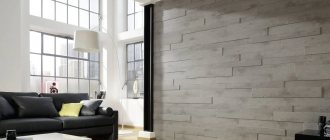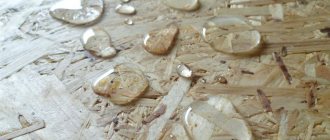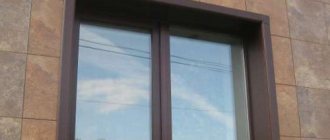What are they made of?
The starting raw material for PVC wall panels is polyvinyl chloride , which is poured into a die (mold) under high pressure.
This method is called the extrusion method. , ground natural chalk is added to the material , the amount of which, as a rule, is no more than 40%.
In addition to painting, panels are decorated using thermal printing or offset printing, but the latter method is used less frequently due to its higher cost.
Thermal printing is applied on a special machine using a hot roller, which presses the thermal film to the surface of the product. In this way, it is possible to achieve quick transfer of the design and a clear and bright print, and the panel itself does not need to be treated with varnish , unlike the use of offset printing.
How to connect MDF panels?
Installation of MDF may seem complicated only at first glance, in fact, the entire structure is assembled similarly to a children's construction set, and even someone who has never picked up a tool in their life can radically change the situation.
Fastening panels may resemble the same process with PVC, but it also has its own characteristics. The connection between each other is carried out using a tongue and groove, each of the panels has one side pointed, and the opposite side is forked, thus, by inserting the point into the groove, a prefabricated structure is obtained.
For fastening to the wall, it is necessary to arrange lathing, unlike PVC, MDF is sensitive to moisture released from concrete, and the air gap will ensure air circulation.
The sheathing should be made of wooden planks, but panels can now be attached to them using glue. Or mechanical fasteners.
It should be borne in mind that by gluing the panels, you lose the possibility of quick disassembly, and if it is torn off, the decorative film will also be torn off, so only one side of such a panel can be reused.
For mechanical fastening, nails and special fasteners are used - clamps; if necessary, such cladding can be disassembled quite quickly.
Features of the material
PVC panels are one of the modern types of finishing material, which is made by extrusion and is used both in the bathroom and in the living room. The main raw material in the production of such products is polyvinyl chloride, which is used to fill the casting mold. So that the panels can be given the desired color, a certain amount of crushed natural chalk is added to their composition.
Decorating PVC panels can be done in one of the following ways:
- coloring;
- thermal printing;
- offset printing.
Thermal printing is applied to a plastic surface using a special roller heated to high temperatures, which presses the film to the surface of the product. Thanks to this technology, it is possible to quickly and clearly apply a design without loss of image brightness. The panel itself does not require additional varnish. Offset printing is used much less frequently due to its high cost.
Jigsaw
Using such a power tool will help you cope with cutting panels and will reduce labor intensity compared to a hacksaw or construction knife. It is convenient to use a jigsaw when preparing a large number of workpieces.
When performing work, the cut location is first marked on the front surface, and then smoothly cut to the required size, drawing the tool along the marking line. Cellophane or other material is placed under the support foot of the jigsaw to prevent scratches on the PVC panel. In the case of simultaneous cutting of several workpieces, they are held together with plastic clamps or wrapped with transparent tape. In this case, it is better to isolate the front surface from tape (lay a sheet of paper).
Application of panels
During the sheathing process, you must initially decide on the tool to use for cutting the plastic panels. This material is widely used for finishing balconies or bathrooms because it has an excellent set of properties. We must also not forget about its practicality, which makes it even more popular. Plastic panels also attract buyers due to their low cost and beautiful appearance.
Each owner can independently decorate the bathroom at home and at his own discretion , because there are a huge variety of panel options that can be used for this. All PVC panels are made to a standard length of 3 m. This is not always practical because it requires cutting into pieces to obtain the desired size.
Difficulties in cutting siding
Regardless of the material used, siding panels have a complex shaped profile. One of their longitudinal edges has a lock, and the second has a counterpart that snaps into a groove, and a perforated strip for attaching to the frame. The visible part of the panels is embossed and can consist of one, two or three waves of the same shape. And their thickness does not exceed 1.2 mm.
It is the convex relief, combined with the small thickness and the presence of hard multi-layer interlocking sections, that causes difficulties when choosing a tool for cutting siding. As practice shows, different devices are more convenient for each type of cut.
Shape and dimensions of standard vinyl siding Source montazh-saidinga.ru
Depending on the installation location, facing panels must be cut in the following ways:
- along the entire lamella to adjust its width to the cornice at the top of the wall;
- across the lamella to obtain the desired length;
- at an angle for facing the pediment and its design along the slopes;
- production of figured cuts for installation around openings and protruding elements of the facade.
In each of these cases, you need to choose what will be the most convenient, easiest and fastest way to cut the siding.
Extensions for decorative cladding have an even more complex shape. And if, when cutting panels, a neat edge is not very important, since it will hide in the grooves of the trim, then the appearance of the extensions should be impeccable.
External corner for siding Source domstyle.by
Which tool is suitable for cutting plastic panels?
Finishers have many ways to cut plastic in their arsenal. And everyone who carries out repairs on their own can choose any of these methods, use professional tools or improvised means, based on their needs and capabilities. Let's take a closer look at all the pros and cons of each method:
- Plastic cutter Plastic cutter . Sold at any hardware store. With its help, you can make an absolutely even cut on a PVC panel without much effort. The only downside is that it only cuts in a straight line, so you won’t be able to make rounded cuts. If desired, you can construct the cutter yourself - from a strip of metal about 1 cm wide and 2 mm thick. One side will need to be sharpened at an angle of 45 degrees, and the handle will need to be wrapped with electrical tape so as not to cut your fingers while working.
- Hacksaw . For plastic, a tool with small teeth is suitable; pay attention that the teeth on the blade are not spread in different directions. This way the cut will be even, smooth, and the plastic will not become frayed. It is convenient to use a hacksaw to cut several panels at once, stacking them on top of each other.
- Jigsaw . With it, the process of cutting panels will be much faster than with a hand tool. But there are some nuances of working with a jigsaw: Jigsaw1. you should immediately turn off the pendulum stroke. 2. use a file with fine teeth. 3. adjust the speed of the saw (choose the lowest so as not to melt the cut). A jigsaw will do an excellent job of cutting stacked panels, the main thing is that the height of the stack does not exceed the length of the file.
- Bulgarian . The most convenient tool for cutting PVC panels, using a grinder with a cutting disc you can make both straight and shaped cuts. It must be remembered that when cutting plastic, the tool must operate at the lowest speed, otherwise the cut edge will melt and the panel will be damaged.
- Knife . If you don’t have a more convenient tool, you can use a simple kitchen or stationery knife. The narrower the knife blade, the easier the cutting process will be. A bread knife with a serrated blade is ideal; it leaves a smooth edge without breaking or fraying.
Cutting panels at home
You can also cut with a jigsaw
It is quite possible to saw a sheet of chipboard or laminated chipboard by hand. True, in this case you are unlikely to be able to avoid the appearance of chips and burrs, but you can try to reduce their number and size.
There are several rules that should be followed when cutting chipboard panels:
- Sheets must be cut on a flat, hard surface. For sawing large panels, you can adapt two large tables (their height should be the same!);
- in order to prevent chipping, stick adhesive tape or good masking tape along the cut line, which will hold the edges of the laminated layer;
- For sawing with a hand saw, select a blade with a grinding tooth. The saw teeth should be sharpened well. You need to drive the saw with slight pressure, at an acute angle to the surface, constantly monitoring its position;
- To cut chipboards and laminated chipboards using a jigsaw, the cut line should be scratched or even cut through. It is best to use a sharp knife to cut through the durable laminate layer;
- install a file with fine reverse teeth;
- select the maximum speed of the jigsaw, turn off the “pendulum”;
- fasten an even strip along the cut line and move the jigsaw strictly along it;
- The jigsaw should be pressed firmly against the surface being cut.
All these recommendations help to correctly saw and cut chipboard, but chipping, nevertheless, cannot be completely avoided
Material cutting rules
After you decide what you will use to cut the plastic panels, take the necessary measurements; you need to draw a cut line on the front side of the panel. You can use a felt-tip pen for this. It will be clearly visible, and after cutting the line can be erased. When cutting, you must wear gloves and goggles to prevent splinters from getting into your skin or eyes.
Cutting is done on the front side. It is necessary to give the panel a slight slope. There shouldn't be any strong pressure. If you use an electric jigsaw, you need to turn off the pendulum motion of the device. It is advisable to make several test cuts first to determine on which side of the panel the jigsaw creates an even cut. Using this device you can cut several panels at the same time.
Many craftsmen, when choosing what to use to cut panels, prefer a construction knife. You can make this tool yourself from a metal sheet by sharpening one edge at an angle of 45°. With the help of such a knife, you can even carefully create cuts of complex configurations.
Things to consider before cutting
The panels should not be overheated, nor should they be cut at sub-zero temperatures
. Before cutting PVC panels, you need to take into account:
- Low resistance to heat - plastic is not designed for operation above +50– +60°C. At a temperature slightly above +100°C, it begins to melt and deform. Therefore, cutting tools should not be used that heat the material.
- Operating conditions – as the temperature drops to 0°C and below, the plastic becomes brittle. When cutting plastic panels during winter work, you need to be extremely careful. It is advisable to cut in a room where the temperature is higher. Before installation, the panels are taken out to a barn or under a shed so that they adapt to the cold. In this case, the increased fragility no longer matters.
- Dimensions - the standard length of the facing sheet is 3 m. It is inconvenient to work with such large panels. However, in addition to the usual cut along or across, you will need shaped cutting of PVC. To do this, you need to choose a tool that is more maneuverable.
The material has a uniform structure , so it can be cut in any direction. It is important to choose the right tool.
Hacksaw
A hacksaw is a universal tool that is available in the arsenal of any craftsman. It can be used to easily cut plastic wall panels if it is not possible to purchase a special cutter. Using a hacksaw, the cutting process takes longer, but with a small amount of work this does not significantly affect the duration of wall cladding.
When sawing plastic with a hacksaw, the following nuances must be taken into account:
- To cut PVC, use a tool with fine teeth for wood (crosscutting) or metal.
- To cut plastic, you do not need to apply strong force, otherwise you can damage the material.
- Using a hacksaw, you can cut several panels at once by stacking them.
Please note that when processing plastic, the cut may become jagged if you use a tool with teeth spread in different directions.
How to cut MDF panels?
The length of the panels is more than two meters, so, especially if you don’t have your own transport or it’s inconvenient to transport, they are cut right in the store, but what should you do at home if sawing is necessary?
The following equipment is recommended for cutting:
A hacksaw for wood – it is not recommended to use a very large tooth, otherwise the edge will turn out loose, in addition, the teeth can catch and pull the decorative film along with them;
A hacksaw for metal – cuts accurately and carefully, but slowly, so it can be used for isolated cases when something needs to be adjusted;
Grinder with a cutting wheel - cuts quickly and accurately, but a lot of dust is generated, so it is suitable for working outdoors, or during major repairs;
Jigsaw - suitable for indoor work, since it is possible to connect a vacuum cleaner to it.
In isolated cases, you can use a metal sharpener or a mounting knife for adjustment, provided that the panel thickness is no more than 3 mm.
The blade is pressed forcefully against the material, after which a sharp cut is made and the fragment is broken off with your hands, while cutting the film on the opposite side with a knife; metal scissors can be used in the same way.
How to cut PVC panels correctly?
When cutting, place the panel on the front side
. To successfully cope with the task, it is worth knowing some secrets of cutting plastic. This will significantly reduce the number of rejected and damaged panels, and will save the novice craftsman from wasting time, money, and, above all, from injury.
- If you are carrying out finishing work in the cold season, do not cut panels that have just been brought in from the street. Let them warm to room temperature. The best option is to keep them at room temperature for at least 1 night. Otherwise, the plastic, which becomes brittle in the cold, will break off in large pieces, and cracks may appear along the entire length of the panel.
- Regardless of which cutting method you choose, the panels should be placed face up (photo above), otherwise the panel may become deformed and its installation will be difficult. In addition, if you make an incision from the inside out, the front side may become covered with microcracks, which will only reveal themselves over time, ultimately ruining the design. It will not be superfluous to mark the cutting line in advance; a simple pencil or felt-tip pen (which can easily be erased from the surface after finishing work) and a student’s ruler are suitable for this.
- To cut several PVC panels at the same time, you need to stack them and provide a two-point support for this stack so that the panels do not sag. It is also worth resting the opposite edge of the stack against the wall, otherwise the panels will move during cutting and you will end up with parts of different lengths.
How are plastic panels cut? Tools and rules of work
Quite often in residential apartments and offices you can find walls and ceilings decorated with plastic panels. And this is not at all surprising, because this material is quite inexpensive, easy to use and retains its excellent appearance for a long time. And it’s incredibly easy to use. Even a person who is working with it for the first time is unlikely to have any difficulties.
But stores mainly sell panels 2.4 meters long. Therefore, during repairs, you have to cut the panels to the required sizes yourself. And the question arises: “How are plastic panels cut?”
Knife
You can also use a simple knife, only after sharpening it as best as possible. Although this is not the best solution, or rather, the most unfortunate. After all, the cutting method is not suitable for cutting panels. But still, this tool will ultimately cope with the task.
It is convenient to cut the panel with a stationery knife. To begin with, an incision is made along the line from above, and then the material is broken.
Or you can make a knife yourself: cut one side of a piece of cast steel at an angle of 45 degrees and sharpen it, and wrap the handle with electrical tape to make it comfortable to hold.
But it is more convenient and reliable to purchase a special construction knife. Among all the answer options to the question of how plastic panels are cut, the last one is the most suitable.
Saw
If a wood saw is used, the teeth should be for cross-cutting or mixed sawing, and preferably undone, then the plastic will be cut neatly and evenly. Therefore, a saw is not the worst answer to the question of how to cut plastic panels.
Bulgarian
A grinder is a good option for working with panels. But there is one important nuance: you need to work with this tool extremely carefully, because plastic is an incredibly fragile material and there is a possibility that it will break. After cutting with a grinder, you need to sand the corners with a special machine. If it is not found in construction equipment, it is better to look for another method.
Power tools
If someone is wondering how to cut plastic wall panels, and among the tools there is an electric jigsaw, then you can cast aside all doubts and use it. After all, this is one of the power tools that is suitable for this task. But first you need to try cutting the unnecessary piece. And all in order to understand which side will be cut neatly. There is also an important detail: the file must have a fine tooth, and the pendulum stroke must be disabled
So, paying attention to all the recommendations, you can cut the panels without any difficulties. Moreover, this method significantly saves time, because with the help of an electric jigsaw you can cut several panels at once, simply by folding them evenly together
Hacksaw
But often when thinking about how to cut PVC plastic panels, the choice falls on a hacksaw for metal or wood, but it is important that the teeth are small. The advantage of this method is that you can cut several panels at the same time
It is necessary to saw with the front side, at a slight angle and try not to press too hard on the material.
Rules for cutting panels
If the panels are just brought in from the street, especially if the temperature there is low, in this case you cannot immediately begin work. They need to warm up for some time, since when cold they become even more fragile and the material can easily be damaged.
Before you start cutting, you need to mark where the cuts will be. A felt-tip pen is best suited for these purposes. It is clearly visible on the panel and can be easily washed off later.
While working, we must not forget about safety precautions; it is better to wear gloves and goggles. The thing is that when the panels break, they form very sharp fragments, and there is a danger of getting hurt by them.
In general, this material is very fragile, so you need to work with it very carefully and carefully. Therefore, if someone else is asking themselves: “How do they cut plastic panels?” - then we can safely say that there are many options
And in the end you will definitely find the most suitable one.
Therefore, if someone else is asking themselves: “How do they cut plastic panels?” - then we can safely say that there are many options. And in the end you will definitely find the most suitable one.
Molar knife
The simplest tool for cutting PVC. But for an unusual kitchen or shoemaker, all you need is a molar knife.
Its blade, while new, is very thin and sharp. And when it gets dull, the blade can be replaced instantly. By biting off a piece or inserting a new one. An ordinary knife is inconvenient and cannot be sharpened quickly. Also, it won't be as thin.
The molar knife is limited in its capabilities. You can only cut the panel lengthwise with it. Of course, you can try to make a cut across. But nothing good will come of this.
How to cut panels lengthwise? This is difficult to explain within the scope of this article. However, the basic principle can be described.
The blade extends a short distance of 3 mm.
From the back side of the panel we select the place where the cut will be made.
Then we cut out a strip, from edge to edge (we are talking about the internal edges of the panel). A cut is made near the rib, then another cut is made near the adjacent one. We make cuts along the entire length.
A strip of plastic falls out and a groove forms.
Then, on the same back side, you need to make a shallow incision near the desired rib. And break the body over it.
The molar knife has the advantages of being fast, quiet and simple. Its disadvantages are that the panels can only be cut lengthwise.
Video “How to cut plastic skirting boards”
This video describes in detail how to cut a plinth using a miter box and how to join floor and ceiling plinths in external or internal corners.
We recommend that you read
Which plinth is suitable for a stretch ceiling and how to glue it
How to make a warm baseboard using European technology
How to join ceiling plinths or cutting methods
Jigsaw
This tool can be called the main one. A jigsaw is good for everyone and has a minimum of disadvantages. Panels can be cut lengthwise and crosswise. You can cut shapes with ovals and other broken things.
The jigsaw has a special feature. It tears the edge of the panel in places where there is very little to cut. At this time, very often the panels burst (especially in cold weather).
Therefore, it is worth using a file with a minimum tooth. For ourselves, we chose a Bosch metal blade with a 0.8 mm tooth. This file will protect you as much as possible from a torn cut.
If the jigsaw operates at high speeds, you can cut with such a file very quickly. This file is for metal and does not become dull when cutting plastic products.
The main advantage of a jigsaw is its versatility. You can cut PVC panels lengthwise and crosswise. In any spatial position.
The downside of a jigsaw is its weight and the presence of a wire. If the blade is chosen incorrectly, the cut will be torn.
There is one secret
When you have to prepare a lot of frame-sized sticks. For example, you need to cut 20-30 pieces at once.
And so as not to cut one thing each time, but to increase the speed. You can resort to one secret.
You will need clamps (presses) as in our photo. Take several at once, usually 5 pieces. Adjust them so that they do not stick out from each other and clamp them with presses. Two pieces on each side of the panel.
And cut quietly. In this way you can cut up to 5 panels at a time. You can cut more, but the Bosch file does not allow this.
You will speed up the cutting process five times and make your work easier.
How to cut plastic panels correctly?
To get a good result when cutting you need to follow specific rules . Among them there are both general instructions and recommendations for working with a specific tool:
- It is not permissible to work with material that has been brought in from the cold - it should be burned before cutting. Cooled PVC becomes brittle, which leads to chipping along the cut edge.
- The slatted panels should only be cut from the front side. Otherwise, the profile will become wrinkled, and there may be difficulties during the installation process.
- Using an angle grinder, an electric jigsaw or a hacksaw allows you to cut a stack of panels at once .
- When working with a knife, it is necessary to use a guide on which the tool will rest during cutting.
In this case, they must be placed on two supports so that they do not sag, and the uncut edge must be rested against the wall - this will prevent the panels from moving during cutting. When using a power tool, it would be a good idea to wear safety glasses, since the likelihood of splinters getting into your face during work is very high.
This, as we have already said, can be a square or a wooden strip . The guide is placed to the cut line, the panel is cut and broken, then the material is trimmed on the other side.
That's all. The main methods of cutting PVC panels have been discussed and all that remains is to decide on the best option, the selection of which depends on the master’s own preferences and capabilities. For a comfortable method of cutting PVC panels with a hacksaw, see the video below:
[custom_ads_shortcode1]
Grinder (angle grinder)
Not every grinder is suitable for cutting panels. It should be small so that you can easily hold it with one hand. You won't be able to use a large grinder.
The thinnest disc of 0.8 mm, 1 mm or a maximum of 1.2 mm is installed in the grinder. The disk used is a regular one for metal.
The grinder gives an amazingly even cut, without nicks and, as people say, “snot.”
The grinder does not tear plastic. It doesn't matter what part of the panel you cut and in what weather. Both in cold weather and in hot weather - using a grinder, you will get an even cut.
Using a grinder, you can cut literally millimeters from a wall panel.
The disadvantages include the fact that it is heavier than a jigsaw, and even more so a knife. But the biggest disadvantage is that the grinder produces a lot of fine dust. It gets everywhere.
Bulgarian
To carry out such work, using a large angle grinder will be inconvenient and unnecessary. A small grinder with a thin metal disc (0.8-1 mm) is best suited.
If it is necessary to simultaneously cut a large number of panels, they are fastened together and markings are applied. The cut is made from the front or back side. The quality of the end is obtained without defects. This power tool allows you to efficiently cut a panel or several at once.
Universal cutter
The universal cutter is called by different names. It has many manufacturers. When we bought our tools, one of the leading manufacturers was Bosch.
The tool is not cheap. But once you buy it, you won’t be able to get by with anything else.
The cutter, unlike all other tools, makes oscillatory movements.
We mainly use two main types of files: wide - 25mm*40mm and narrow 10mm*20mm.
Very often during installation, you need to cut the PVC panel in place. Often this can only be done with a Bosch cutter. It is impossible to get into difficult places with any other tool.
The cutter greatly simplifies the work and speeds it up. Wall products can be cut lengthwise and crosswise. You can even cut off the top or bottom layer of the panel.
Let's talk about the cons. The price of the tool and its consumables is off the charts. For example, a file for a jigsaw will cost 100 rubles, and a file for a cutter will cost 800 rubles. Files quickly become unusable.
Choosing a cutting tool
In the process of installing such finishing material at home, users are faced with a small problem: the panels sold in hardware stores are 3 meters long, and the ceiling height in most panel houses is 2.5 meters.
Repair specialists who have to install PVC panels in their professional activities know many secrets regarding the correct cutting of plastic materials lengthwise and crosswise. After analyzing them, every owner who wants to make repairs themselves will be able to choose the most suitable professional tool for him or use improvised means.
The choice of method for cutting panels usually depends on the tasks assigned and the capabilities of the craftsman. Below are the types of cutting materials.
Cutter
Most experienced specialists, whose tools have a wide variety and are designed for high-quality processing of plastic, prefer to cut PVC panels using a special cutter. Thanks to it, without much effort, an even cut is created on the plastic surface, characterized by the absence of nicks and chips. The cutter is sold in almost every hardware store and has a very affordable price.
If necessary, this tool can be made independently from available materials, for which it is enough to adhere to the following recommendations:
- it is necessary to prepare a metal strip, the thickness of which is at least 2 mm and the width is 1 cm;
- then you should cut one of the edges of the workpiece at an angle of 45 degrees;
- it is necessary to sharpen the edge of a homemade product using a sharpening stone;
- the opposite side should be wrapped with electrical tape, which will protect your hand from damage during operation.
A professional plastic cutter has a relatively low cost, so purchasing it can be a profitable investment, because thanks to such a tool, the process of cutting PVC panels becomes not only more convenient, but also quite fast.
Hacksaw
One of the universal devices for cutting any material is a hacksaw, which is likely to be found in the arsenal of any master. This will help you cut the plastic wall panel if necessary. Such work will take more time than using a special cutter, however, with significant volumes of cladding, this will not significantly affect the overall duration of the repair.
When using a hacksaw, you should listen to the following recommendations from experts:
- to work with plastic finishing materials, you should use a tool with small teeth, which is usually designed for working with metal or wood;
- to shorten a PVC panel there is no need to apply strong physical force, which can lead to damage to the material;
- You can cut several parts at once with a hacksaw by stacking them and securing them to avoid deflection or displacement.
To prevent the cut from becoming jagged, it is not recommended to use a tool with teeth spread in different directions.
Power tools
For quick sawing of PVC panels, it is best to have a power tool on hand. For this purpose, you can use almost any device, which will help to significantly reduce the time spent on preparation for installation.
Often cutting is performed using the following devices:
- jigsaw;
- Bulgarians;
- circulars.
When working with plastic material, it is allowed to use only low speeds, because with significant heating it begins to melt and release fumes that are toxic to the human body, and in this case the cut will turn out torn.
Using a jigsaw will help make the process of preparing PVC panels for installation much faster than when using hand tools.
However, with this processing method, the following nuances must be taken into account:
- even before starting work, it is necessary to turn off the pendulum stroke;
- You should use a file with the smallest teeth possible;
- you need to set the saw blade to the lowest speed, which will avoid excessive heating of the plastic at the cut site.
Using a jigsaw is very convenient for cutting stacks of panels, but you should make sure that their height does not exceed the length of the file installed in the tool.
The grinder is recognized as the most convenient and practical power tool with which you can cut PVC wall panels. By installing a cutting disc, you can make not only straight, but also shaped cuts on the surface of the plastic. When processing plastic around the grinder, it turns on only at low speeds, which will avoid damage to the material due to melting of the edges.
Knife
In the absence of more practical and convenient tools, you can cut PVC using a knife.
To solve this problem, the following types of cutting products are suitable:
- Kitchen knife. This tool is suitable for cutting multiple panels during repair or replacement. For large-scale wall decoration, such a procedure is unnecessarily lengthy and painful.
- Construction knife. Among hand-held cutting tools, such a device is one of the best options for achieving an even cut with relatively little effort.
- Stationery knife. Using a wooden ruler or square, this tool allows you to achieve a perfectly even cut of the panel, so it is often used for cutting them.
Basic cutting rules
To ensure that your efforts in cutting PVC panels are not in vain, and that the result of the work meets your expectations, experts recommend adhering to a number of rules for working with plastic. These little secrets will not only help to significantly reduce the amount of spoiled material, but will also protect the craftsman from unnecessary financial expenses and injuries.
When carrying out work during the heating season, you should not start cutting panels that have recently been brought into the room. The plastic must naturally warm up to room temperature, which is achieved in at least 12 hours. The fact is that at low temperatures the plastic panel becomes brittle, and therefore can crack and break off in large fragments.
Regardless of the chosen method of processing the material, it should be placed with the front side facing you, which will avoid deformation of the panel and difficulties during its further installation. When cut from the reverse side, you can find microcracks on the front part, which will appear over time and significantly damage the interior.
It is necessary to mark in advance the straight line of the planned cut, which can be done with a simple pencil and a stationery ruler.
To speed up the process of preparing the material for installation work, you can cut or saw several PVC panels at the same time. To do this, just stack them and create a two-point support. It is best to rest the opposite edge of the stack against the wall, which will help avoid shifting of the products, and accordingly, the result will be parts of the same length.
Cutter
This tool has proven itself well due to its low cost. It is perfect for working at home.
The tool has excellent characteristics, and the surface that can be cut looks smooth. It should also be emphasized that no special physical effort is required to carry out cutting. A huge advantage can also be called its compactness, which does not take up much space when storing it.
Hacksaw
A hacksaw is considered more practical to use, and it doesn’t matter whether it’s for metal or wood. The only requirement when using a hacksaw on wood is the presence of small teeth, which should not be set apart, because this will destroy the surface of the material that needs to be sawed into pieces.
This tool is often used for cross cutting.
The advantage of this tool is the ability to simultaneously cut several panels. For this operation you will need to stack the material.
For convenience when cutting, it is better to place the planks with the front side facing the person performing the work. When reducing the length of the panels, care must be taken not to apply enormous force when pressing the tool, because this can break the PVC sheets.
Jigsaw, circular saw and grinder
These tools greatly speed up the process of changing lengths and also produce a superior looking cut edge. These devices have proven themselves to be excellent if you need to quickly cut a panel lengthwise.
In no case should we forget that when working at high rotation speeds of the cutting tool, defects in the form of melted edges may appear on the surface that is being processed. This releases unpleasant odors and substances harmful to health into the work area. It is necessary to decide which circle to process. In view of this fact, first all work must be done at reduced speed. With the help of a grinder you can get not only straight cuts, but also curly ones.
To obtain a high-quality surface, as well as increased productivity, experts recommend using a regular jigsaw as the tool used when cutting. In this case, you get an excellent, smooth edge that does not have any creases, and is also very practical in the process. The tool has proven itself excellent both when cutting longitudinally and when cutting across the bar.
When using a jigsaw, you need to remember that you need to use a file with a fine tooth
Particular attention should be paid to the cutting mode - the minimum speed is selected and the pendulum stroke is turned off. This tool has proven itself to be excellent when cutting several panels at the same time.
Knife
This tool has proven itself to be excellent if you need to cut a small amount of plastic panels. When using it, you just need to know some little things that can help and facilitate the process of changing the length.
An ordinary kitchen knife, which can be found in any kitchen, is least suitable for such work. Difficulties in working with this cutting tool arise due to the width of its blade. Even if perfectly sharpened, a kitchen knife will not cut wall panels.
A stationery knife is considered a more suitable tool for this, because using it, the material is not completely cut. After passing along the front surface of the material, a groove is obtained. By turning the plank over and pressing on the edges, the PVC panel clearly breaks off along it, and the resulting small fringe, which covers the surface of the fracture, will not harm the appearance of the room in any way, because in any case it will be hidden either under the borders or under the baseboard.
A bread knife made of ceramic can also be used to carry out such work. It will cope perfectly with plastic panels due to the presence of a wavy cutting edge. Working with such a tool, it will not be difficult to obtain an element that will fit perfectly into the interior of the bathroom.
To cut PVC panels, you can use different tools, each of which has its own advantages and disadvantages. There are also specialized professional devices that make cutting faster and easier.
For information on how to cut a PVC panel using a utility knife, see below.
Safety precautions
Don't forget about safety precautions!
When cutting plastic panels, especially with an electric tool (a jigsaw or grinder), there is a high probability that sawdust and fragments will fly off the material. Therefore, it is worth purchasing safety glasses and gloves in advance that will protect your eyes from injury, and it is recommended not to take them off until the end of the work.
Regardless of which tools you decide to use, the above tips will help you avoid the mistakes of most inexperienced decorators and create a cozy interior that will delight you for many years.
How to avoid mistakes
The main mistake when cutting sheets and working with plastic panels is not knowing that PVC sheets cannot withstand low temperatures. You need to work with them at a temperature of plus 5 degrees Celsius, or even more. If the temperature is lower, the viscosity of the panels decreases, which will lead to chips and nicks along the cut line - in the best case. In the worst case, the plastic panel will simply crack or crumble in your hands.
Plastic panels are a material that does not tolerate high temperatures and is quite fragile. This should be taken into account when cutting.
In any case, inaccuracies, errors and punctures are possible. He who does nothing does not make mistakes and does not learn from his mistakes. You just need to know the necessary information, follow the rules, take into account recommendations, calculate everything a couple of steps ahead and then there will be much fewer mistakes.
Before you get started, read the tips and recommendations of experts. This will help avoid mistakes and damaged material.
Cutting Rules
To quickly and accurately cut a workpiece, you need to follow several rules. They “work” for most synthetic materials: organic glass, polycarbonate and others. Let us list the basic rules on how to cut 4 mm plexiglass and other sizes at home.
- It is much easier to make a straight or curved cut if the part is heated. To do this, it is warmed up a little before processing. A hair dryer or gas burner is used as a heat source. Important point. In order not to melt the acrylic, it is kept at a distance from the heating device.
- For work, it is best to choose a canvas marked MP.S. This is high strength hardened steel.
- Sawing with any power tool should only be done at low speeds. Otherwise, the acrylic glass will heat up from the blade and melt. The speed for each device is selected individually.
- Do not cut material without eye protection. You must wear a mask or special glasses. During operation, many very sharp small fragments are formed, which fly away from under the cutting unit.
Knife cutting
When insulating a floor or ceiling using foam boards, it is not at all necessary to use special equipment.
To cut polystyrene foam at home you need to have:
- Nice knife.
- A ruler more than one meter long.
- Pencil.
The procedure for cutting polystyrene foam boards in this way is quite simple:
- First, on the surface of the material, the starting and ending points of the cutting line of the cut are marked with a pencil.
- Next, a ruler is applied to these marks, clamped, and an incision is carefully made along it with a paint knife (it is not necessary to completely cut off the piece of foam plastic).
- The polystyrene foam plate is turned over to the other side, and a cut is made in the same way, parallel to the cut already made.
- After making the cuts, you just need to break the foam along the mowing line.
This method of cutting material is the cheapest, quietest and fastest, and there is practically no debris after finishing the work. Be sure to check the sharpness of the knife before cutting foam.
